Skin Color, Fur Color, And Height Are Examples Of Which Inheritance Pattern?
8.5: Complex Inheritance
- Page ID
- 16764
This photo of a Southward African family shows some of the variations that exist in human skin color. The colour of human pare can range from very light to very dark with every possible gradation in betwixt. As you lot might expect, the skin color trait has a more complex genetic basis than just one gene with two alleles, which is the type of simple trait that Mendel studied in pea plants. Like pare color, many other human being traits have more complicated modes of inheritance than Mendelian traits. Such modes of inheritance are called not-Mendelian inheritance, and they include inheritance of multiple allele traits, traits with codominance or incomplete dominance, and polygenic traits, among others, all of which are described below.
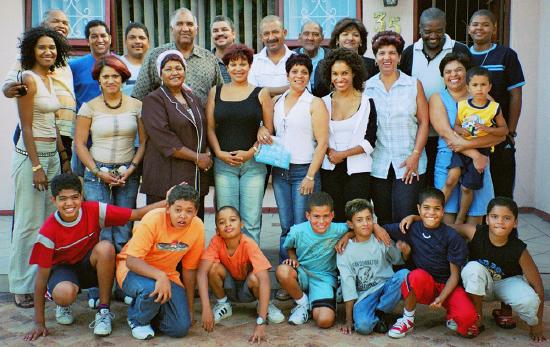
Multiple Allele Traits
The majority of human genes are thought to have more than two normal versions or alleles. Traits controlled past a single gene with more than than two alleles are chosen multiple allele traits. An example is ABO blood type. Your blood blazon refers to which of certain proteins called antigens are found on your red claret cells. There are three common alleles for this trait, which are represented by the letters IA, IB, and i.
| Genotype | Phenotype (blood blazon) |
|---|---|
| IAIA | A |
| IAi | A |
| IBIB | B |
| IBi | B |
| ii | O |
| IAIB | AB |
As shown in the table below, in that location are vi possible ABO genotypes because the three alleles, taken two at a fourth dimension, result in six possible combinations. The IA and IB alleles are dominant to the i allele. As a result, both IAIA and IAi genotypes have the same phenotype, with the A antigen in their blood (blazon A claret). Similarly, both IBIB and IBi genotypes have the aforementioned phenotype, with the B antigen in their claret (type B blood). No antigen is associated with the i allele, so people with the ii genotype have no antigens for ABO claret blazon in their claret (type O blood).
Codominance
Expect at the genotype IAIB in the ABO claret group table. Alleles IA and IB for ABO blood type are neither dominant nor recessive to one another. Instead, they are codominant to each other. Codominance occurs when 2 alleles for a gene are expressed equally in the phenotype of heterozygotes. In the instance of ABO claret blazon, IAIB heterozygotes have a unique phenotype, with both A and B antigens in their blood (type AB blood).
Incomplete Dominance
Another human relationship that may occur between alleles for the aforementioned gene is incomplete authorisation. This occurs when the ascendant allele is not completely dominant, and then an intermediate phenotype results in heterozygotes who inherit both alleles. Generally, this happens when the two alleles for a given gene both produce proteins but one protein is not functional. Every bit a result, the heterozygote private produces only half the amount of normal poly peptide as is produced past an individual who is homozygous for the normal allele.
An example of incomplete dominance in humans is Tay Sachs disease. The normal allele for the gene, in this example, produces an enzyme that is responsible for breaking downwardly lipids. A defective allele for the cistron results in the production of a nonfunctional enzyme. Heterozygotes who accept one normal and one lacking allele produce half as much functional enzyme as the normal homozygote, and this is plenty for normal development. All the same, homozygotes who have only lacking alleles produce but the nonfunctional enzyme. This leads to the accumulation of lipids in the brain first in utero , which causes significant encephalon impairment. About individuals with Tay Sachs affliction die at a immature age, typically past the age of five years.
Polygenic Traits
Many human traits are controlled by more than one gene. These traits are called polygenic traits. The alleles of each gene have a small additive effect on the phenotype. There are many possible combinations of alleles, especially if each gene has multiple alleles. Therefore, a whole continuum of phenotypes is possible.

An example of a human polygenic trait is adult height. Several genes, each with more than one allele, contribute to this trait, so there are many possible adult heights. For case, one adult's acme might be 1.655 m (five.430 anxiety), and another adult'south height might be i.656 one thousand (5.433 feet). Adult height ranges from less than 5 feet to more six anxiety, with males being somewhat taller than females on average. The majority of people fall most the middle of the range of heights for their sexual activity, as shown in the graph in Figure \(\PageIndex{2}\).
Environmental Furnishings on Phenotype
Many traits are affected past the environs equally well every bit by genes. This may be particularly truthful for polygenic traits. For instance, adult height might exist negatively impacted by poor diet or illness during childhood. Skin color is another polygenic trait. There is a wide range of skin colors in people worldwide. In improver to differences in skin colour genes, differences in exposure to ultraviolet (UV) light crusade some of the variations. As shown in Effigy \(\PageIndex{iii}\), exposure to UV light darkens the skin.

Pleiotropy
Some genes bear on more than than one phenotypic trait. This is called pleiotropy. In that location are numerous examples of pleiotropy in humans. They more often than not involve important proteins that are needed for the normal development or functioning of more than 1 organ organization. An example of pleiotropy in humans occurs with the gene that codes for the main protein in collagen, a substance that helps form bones. This poly peptide is also of import in the ears and eyes. Mutations in the cistron result in problems not simply in bones merely besides in these sensory organs, which is how the cistron's pleiotropic effects were discovered.
Some other example of pleiotropy occurs with sickle prison cell anemia. This recessive genetic disorder occurs when there is a mutation in the gene that normally encodes the red claret cell protein called hemoglobin. People with the disorder have two alleles for sickle-jail cell hemoglobin, so named for the sickle shape (Figure \(\PageIndex{4}\)) that their cerise blood cells have on nether sure weather condition such every bit concrete exertion. The sickle-shaped red blood cells clog small-scale blood vessels, causing multiple phenotypic effects, including stunting of concrete growth, certain bone deformities, kidney failure, and strokes.

Epistasis
Some genes affect the expression of other genes. This is called epistasis. Epistasis is similar to potency, except that it occurs between dissimilar genes rather than between unlike alleles for the same gene.
Albinism is an instance of epistasis. A person with albinism has virtually no pigment in the skin. The condition occurs due to an entirely different cistron than the genes that encode skin color. Albinism occurs because a protein called tyrosinase, which is needed for the production of normal skin paint, is not produced due to a factor mutation. If an individual has albinism mutation, he or she volition non have whatsoever peel pigment, regardless of the skin color genes that were inherited.
Do you know your ABO blood type? In an emergency, knowing this valuable piece of information could perchance salvage your life. If you ever demand a claret transfusion, it is vital that you receive blood that matches your own claret type. Why? If the blood transfused into your torso contains an antigen that your own blood does non contain, antibodies in your claret plasma (the liquid part of your blood) will recognize the antigen as strange to your trunk and cause a reaction called agglutination. In this reaction, the transfused red blood cells will clump together, equally shown in the prototype below. The agglutination reaction is serious and potentially fatal.

Knowing the antigens and antibodies nowadays in each of the ABO claret types volition help you sympathise which type(southward) of claret you tin safely receive if you ever need a transfusion. This data is shown in the table below for all of the ABO claret types. For instance, if you have blood type A, this means that your red blood cells have the A antigen and that your blood plasma contains anti-B antibodies. If you were to receive a transfusion of blazon B or type AB blood, both of which accept the B antigen, your anti-B antibodies would assault the transfused crimson claret cells, causing agglutination.
| Characteristics | Type A | Type B | Type AB | Blazon O |
|---|---|---|---|---|
| Red Claret Prison cell | 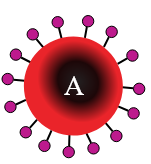 |  | 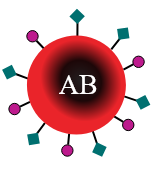 | 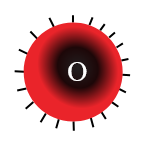 |
| Antibodies in Plasma | Anti-B | Anti-A | None | Anti-A and Anti-B |
| Antigens in Red Blood Cells | A antigen | B antigens | A and B antigens | None |
You lot may accept heard that people with claret type O are called universal donors and that people with claret type AB are called universal recipients. People with type O blood accept neither A nor B antigens in their claret, then if their claret is transfused into someone with a different ABO blood type, it causes no allowed reaction. In other words, they tin can donate claret to anyone. On the other hand, people with blazon AB blood have no anti-A or anti-B antibodies in their blood, so they can receive a transfusion of blood from anyone. Which claret type(s) tin safely receive a transfusion of blazon AB blood, and which blood type(s) tin can exist safely received by those with type O blood?
Review
- What is non-Mendelian inheritance?
- Explicate why the human ABO blood group is an example of a multiple allele trait with codominance.
- What is incomplete dominance? Give an example of this type of non-Mendelian inheritance in humans.
- Explain the genetic basis of man skin color.
- How may the human trait of adult height be influenced by the environment?
- Define pleiotropy, and give a human case.
- What is the difference between pleiotropy and epistasis?
- Which of the following terms best matches each trait description? Cull only the 1 term that all-time fits each trait. (codominance; multiple allele trait; Mendelian trait; polygenic trait)
- A trait controlled by iv genes.
- A trait where each allele of a heterozygote makes an equal contribution to the phenotype.
- A trait controlled past a unmarried factor that has three different versions.
- A trait controlled past a unmarried gene where one allele is fully dominant to the only other allele.
- People with type AB blood take:
- anti-O antibodies
- anti-A and anti-B antibodies
- A and B antigens
- True or Fake . People with type O blood cannot receive a blood transfusion from anyone besides others with blazon O claret.
- Truthful or Faux . People with type O claret can be heterozygous for this trait.
Explore More
Source: https://bio.libretexts.org/Bookshelves/Human_Biology/Book:_Human_Biology_%28Wakim_and_Grewal%29/08:_Inheritance/8.5:_Complex_Inheritance
Posted by: springuply1972.blogspot.com



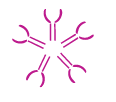





0 Response to "Skin Color, Fur Color, And Height Are Examples Of Which Inheritance Pattern?"
Post a Comment